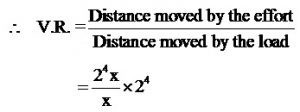First System of Pulleys
In this system, the pulleys are so arranged that there are as many strings as there are pulleys. The end of each string is fastened to a rigid ceiling; while the other end passing round the bottom periphery of the pulley, is fastened to the next higher pulley. The load is attached to the bottom – most pulley; whereas the effort is applied to the far end of the string passing round the last pulley. Another pulley (no. 5) is used just to change the direction of the effort.
The velocity ratio of the system may be obtained by considering a unit motion of the load. In this case, let the weight W be raised by x meters. Since the load is supported on both sides of the string , thus this slackness of x meters will have to be taken up by the pulley 2. If the relative position o the pulley 2, with respect to pulley 1, is to remain undisturbed, then the pulley 2 should move upwards through a distance of 2x meters. Now this upward movement of pulley 2 through a distance of 2x meters will cause a total slackness of 2(2x) = 22x meters, this causing a slackness of 2(22x) =22x n the string passing round the pulley 4. Thus the pulley 4 should move upwards through a distance of 23m meters causing a slackness 2 (23x)meters=24x meters, which must be taken up by the free end of the string to which the effort is applied. Thus the effort must move through a distance of 24x meters


Thus, in general if there are x pulleys in the system then,
V.R. = 2n
Now

and efficiency 